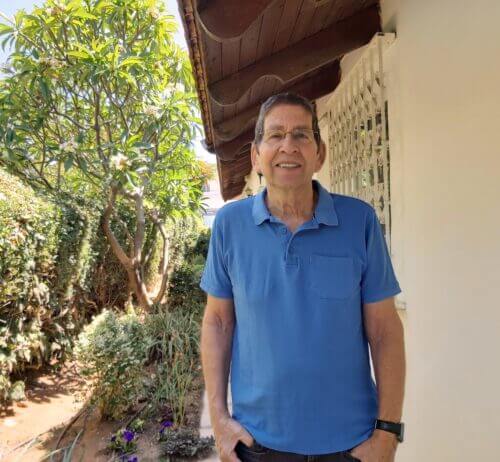Says Prof. Hagai Netzer from the School of Physics and Astronomy at Tel Aviv University who wrote dozens of joint articles with Ganzel

Nobel laureate Reinhart Ganzel is a great friend of Israeli science. Says Prof. Hagai Netzer from the School of Physics and Astronomy at Tel Aviv University who wrote dozens of joint articles with Ganzel. The list of Ganzel's scientific partners in Israel also includes Prof. Amiel Sternberg (also from Tel Aviv University, see separate interview) as well as Prof. Avishi Dekal and Prof. Ram Sri from the Hebrew University.
Ganzel is a scientist of the highest order, but the thing that sets him apart apart from his extraordinary understanding in all areas of astronomy and physics is the ability to organize groundbreaking experimental projects one by one, and he has been doing this for many years, starting with the idea of what device to build to the planning, construction, mounting on the telescope and its use. They achieved his and Andrea Gaz's findings thanks to the devices they built with their own hands. These are huge devices, one size better than the other. Ganzel leads the field of infrared astronomy thanks to a collection of instruments that are always the best. In astronomy, usually whoever manages to build the best instrument does the best science. But it is a difficult and expensive competitive task.
It is worth mentioning the last device he built, Gravity, which is built for observations of black holes and around black holes. It is an interferometer that is connected to the Very Large Telescope (VLT) a collection of four large telescopes at the European Southern Observatory in Chile, an amazing device in terms of its precision - an incredible resolution of less than a thousandth of a second of arc. This is a separation capacity much greater than that of the Hubble found in space.
Much of his work deals with the study of black holes with a very strong emphasis on the black hole at the center of our galaxy. Here, too, we are talking about decades of work and the construction of three different devices, of which the Gravity is the last. Each such device pushed the limits and little by little as the limits improve or sharpen we get closer and closer to the black hole. You can see things moving closer and closer to the black hole. The ability to find their properties: size, how they behave, how material is attached to them always depends on the ability to approach them. As you get closer and see more details, you can check its features."

"This is not the only science he does, he is a director at the Max Planck Institute who is responsible for astronomy in the infrared field. There is a large project there on galaxies in the early universe and the findings in this field are also the best of their kind there. But like the members of the Nobel committee I would rate the black hole at the center of the galaxy as the most important discovery.
"Andrea Getz started after him, she works at the Kek Observatory in Hawaii. Her group has been building separate devices that compete with Ganzel's group for many years. Until ten years ago it was a close competition. A large part of the discoveries in the center of the galaxy was made simultaneously by both of them, each with his own instrument and his own group. It is the duty of the Nobel Prize Committee to check whether there are significant partners for the winner." Ganzel won the Harvey Prize distributed by the Technion.
"As for the third partner - who won half of the Nobel Prize, Penrose received the Wolf Prize in 1988 together with Stephen Hawking, for two different aspects of black holes: Penrose for basic theories about black holes, for proof of their existence and the event horizon, and Hawking received for what was later called Hawking radiation. That's why Penrose is one of the people who ask how come he hasn't received it until today."
More of the topic in Hayadan:
- Roger Penrose and the two black hole detectors at the center of the galaxy won the Nobel Prize in Physics
- "Without the observations of Ganzel and Gas, the whole subject of black holes would have remained theoretical"
- The Laboratory for Testing General Relativity: The Supermassive Black Hole and the Star
- In the last twenty years we have discovered a lot of planets, so why haven't we found aliens? (On Hagai Netzer and Ami Ben Best's book "Meetings for the Milk"

One response
Penrose did not receive the award until this year (Hawking died before he received it, so he will not receive it either) because the award committee is afraid to give it to a theory that has not yet produced experimental results that show that it is not only reasonable but also the only one capable of guessing them with a degree of accuracy that does not leave much room for hesitation. To remind you, Einstein did not receive the prize for his revolutionary theory of relativity, but for a less important paper - but one whose role cannot be denied in explaining a phenomenon that every researcher can see with his own eyes, only needing a medium microscope. Penrose's work is much less inevitable. He proved mathematically that stars of a certain size and above not only can collapse into a black hole state (this was proven before him, although with certain assumptions about the symmetry of the star) but also that this is an inevitable result of the theory of relativity, without conditions and without assumptions.